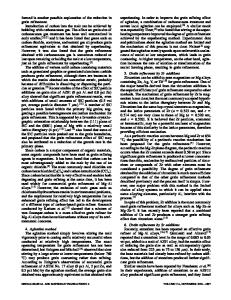The critical role of QM/MM X-ray refinement and accurate tautomer/protomer determination in structure-based drug design
- PDF / 2,975,659 Bytes
- 19 Pages / 595.276 x 790.866 pts Page_size
- 87 Downloads / 296 Views
The critical role of QM/MM X‑ray refinement and accurate tautomer/ protomer determination in structure‑based drug design Oleg Y. Borbulevych1 · Roger I. Martin1 · Lance M. Westerhoff1 Received: 17 June 2020 / Accepted: 12 October 2020 © The Author(s) 2020
Abstract Conventional protein:ligand crystallographic refinement uses stereochemistry restraints coupled with a rudimentary energy functional to ensure the correct geometry of the model of the macromolecule—along with any bound ligand(s)—within the context of the experimental, X-ray density. These methods generally lack explicit terms for electrostatics, polarization, dispersion, hydrogen bonds, and other key interactions, and instead they use pre-determined parameters (e.g. bond lengths, angles, and torsions) to drive structural refinement. In order to address this deficiency and obtain a more complete and ultimately more accurate structure, we have developed an automated approach for macromolecular refinement based on a two layer, QM/MM (ONIOM) scheme as implemented within our DivCon Discovery Suite and "plugged in" to two mainstream crystallographic packages: PHENIX and BUSTER. This implementation is able to use one or more region layer(s), which is(are) characterized using linear-scaling, semi-empirical quantum mechanics, followed by a system layer which includes the balance of the model and which is described using a molecular mechanics functional. In this work, we applied our Phenix/ DivCon refinement method—coupled with our XModeScore method for experimental tautomer/protomer state determination—to the characterization of structure sets relevant to structure-based drug design (SBDD). We then use these newly refined structures to show the impact of QM/MM X-ray refined structure on our understanding of function by exploring the influence of these improved structures on protein:ligand binding affinity prediction (and we likewise show how we use postrefinement scoring outliers to inform subsequent X-ray crystallographic efforts). Through this endeavor, we demonstrate a computational chemistry ↔ structural biology (X-ray crystallography) "feedback loop" which has utility in industrial and academic pharmaceutical research as well as other allied fields. Keywords CSAR set · X-ray crystallography · Quantum mechanics X-ray refinement · Ligand strain · high throughput crystallography · protonation states · tautomers · difference density Z-score · Structure guided drug discovery · Structurebased drug discovery
Introduction Thanks in large part to their speed and lower cost, virtual screening, docking, and scoring have become integral to the drug discovery process as these methods have become critical tools in the structure based drug design (SBDD)
Electronic supplementary material The online version of this article (https://doi.org/10.1007/s10822-020-00354-6) contains supplementary material, which is available to authorized users. * Lance M. Westerhoff [email protected] 1
QuantumBio Inc, 2790 West College Ave, Suite 900, State College, PA 16801, USA
Data Loading...











